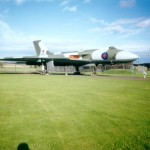by Dave Gemmell ZS6AAW
and the Broomstick Warriors.
46th JOTA/JOTI. {18 – 19/10/2003}
Well, the 46th JOTA/ 7th JOTI has come and gone, but certainly not forgotten!! Many thanks to the following Hams and stations who supported the Guiding and Scouting movements over this notable week-end!
ZS1CT/P, ZS1B BUDDY, Cape Town, – ZS3KBS, Kimberly,
ZS4BS DENNIS BLOEMFONTEIN – ZS4WRC/ZS4NS NICO – WELKOM
ZS6ABD RON – LADISMITH/NATAL, ZS6ARV JAN – JOHANNESBURG,
ZS5PMB/ZS5RK ROD – PIETERMARITZBURG/NATAL,
ZS5ZLB/ZS5WI WILLIE ESHOWE/ZULULAND, ZS6ARV JAN
ZS6BP/JOHN ZS6RNA / ZS6RN NIGEL – ARROW PARK/EAST RAND
ZS6SRC/ZS6AYC SID – SECUNDA/GAUTENG
ZS6WRS – WHITERIVER/MPUMALANGA
A extra special thanks goes to following people who sent in reports;
ZS1B BUDDY, JOHN ZS6RNA, Mercia ZR5MMG,
DC. Anthony Mac Gregor. – Northern Natal
Glynis Longhurst – Akela, 1st Eshowe Cubs
Dawn & Paul Smit, Bradley Davies – 1st Secunda Scout Group
Many thanks must also go to the Hams not mentioned here but whom, nevertheless, contributed to JOTA unfortunately the only …..?????
RADIO versus the “PLASTIC BRAIN”.
(Hopefully, the following paragraphs may simulate a bit of discussion!!!)
As I edit these reports I have noticed a few “things” as far as South Africa is concerned and would like your comments when comparing them to the rest of the World. Actually it was the following comment about JOTI by Buddy ZS1B which set me thinking!
“It was obvious that they found HF ham radio the most popular with echolink being a close second, while the JOTI activity seemed to be a poor 3rd, judging by the comments of the scouts. They are looking forward to next year’s event”.
The summary of the various modes used during JOTA/JOTI are as follows:
a) AMATEUR RADIO.
Cape Town ZS1CT/P controlled by Buddy ZS1B. More than 80 contacts were made with 40 countries, of which a total of 31 were JOTA stations.
b) ECHOLINK.
Only Cape Town ZS1CT/P reported 15 QSOs were via echolink to 9 countries. Kevin ZR1KDG on 2 metres where he had fun working through a local repeater which was linked to ZR1EL, who effected the Echolink for most of the weekend.
c) IRLP.
No JOTA station in SA seems to have used this mode !!! As far as I know there are only two IRLP repeaters ZS5DBN in Durban and ZS6ERB east of Jo’burg.
d) INTERNET.
Only Cape Town ZS1CT/P and Secunda ZS6SRC reporded any JOTI activity but only ZS6SRC sent full details, an abbreviated “table” of which appear below.
SECUNDA JOTI CONTACTS
Australia = 9, Netherlands = 6,
United Kingdom and Johannesburg = 3 each
Gauteng, Germany, New Zealand and Mexico = 2 each
Botswana, Brazil, Nepal, Ireland, Norway, Peru, Phillipines, Singapore,
Slovenia, and Sweden = 1 each (total of 30)!
So that’s the sum total of what I know about bringing JOTA/JOTI up-to-date!!! Are these details accurate? Do they give a true reflection of the interest in JOTA and thus an interest in Ham Radio?
Personally, I don’t see Ham Radio, as we know it, to be threatened by computers in general. The only suggestion I can make is that more accent be placed on “homebrew” equipment and special events. In other words activities in which young and old can partake. Believe me many ham radio activities do not need much supervision only a little effort on the part of the beginner or the ham. JOTA provides a very good “testing ground” for my statement.
There are enough complaints/suggestions about how to Modernize/ Update ham radio using the computer but judging from the JOTA reports I received (6 in total) what has happened? Then there’s the report from Northern Ireland about GN4SIW being the one of the few JOTA stations in that country!
My opinion is that every hobby seems to be going through a “dip” but in difference is killing the hobby! Any suggestions of how we can overcome this apathy before it does any real damage? At least, as far as Ham Radio is concerned.
“THE ADVANTAGE OF SARL MEMBERSHIP.
I received the following message from David GI4FUM from Northern Ireland!
“I got your email details from the SARL bulletin. I’m a SARL member. Just to let you know that GN4SIW will be one of the very few JOTA stations QRV from Northern Ireland. It is being run by Antrim and District Amateur Radio Society from the scout hall in the town of Randalstown which is about 25 miles North West of Belfast. I am chairman of the club and also the district commissioner.”
Once again! My plea for more info. from you chaps! This column of yours needs some livening up! Please send contributions (even in rough form) to:-
davegemmell@bmknet.co.za and P.O.BOX 77, IRENE, 0062 and TEL: and FAX: 012 – 667 2153 (NB. Please ask for the FAX!) MNI TNX.

